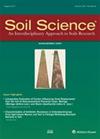Supplementary material to "Estimating soil fungal abundance and diversity at a macroecological scale with deep learning spectrotransfer functions"
4区 农林科学
Q2 Agricultural and Biological Sciences
引用次数: 7
Abstract
Abstract. Soil fungi play important roles in the functioning of ecosystems, but they are challenging to measure. Using a continental scale dataset, we developed and evaluated a new method to estimate the relative abundance of the dominant phyla and diversity of fungi in Australian soil. The method relies on the development of spectro-transfer functions with state-of-the-art machine learning and using publicly available data on soil and environmental proxies for edaphic, climatic, biotic and topographic factors, and visible--near infrared (vis–NIR) wavelengths, to estimate the relative abundances of the Ascomycota, Basidiomycota, Glomeromycota, Mortierellomycota and Mucoromycota and community diversity measured with the abundance-based coverage estimator (ACE) index. The machine learning algorithms tested were partial least squares regression (PLSR), random forest (RF), Cubist, support vector machines (SVM), Gaussian process regression (GPR), XG-boost (XGB) and one-dimensional convolutional neural networks (1D-CNNs). The spectro-transfer functions were validated with a 10-fold cross-validation (n = 577). The 1D-CNNs outperformed the other algorithms and could explain between 45 and 73 % of fungal relative abundance and diversity. The models were interpretable, and showed that soil nutrients, pH, bulk density, an ecosystem water balance (a proxy for aridity) and net primary productivity were important predictors, as were specific vis–NIR wavelengths that correspond to organic functional groups, iron oxide and clay minerals. Estimates of the relative abundance for Mortierellomycota and Mucoromycota produced R2 ≥ 0.60, while estimates of the abundance of the Ascomycota and Basidiomycota produced R2 values of 0.5 and 0.58, respectively. The spectro-transfer functions for the Glomeromycota and diversity were the poorest with R2 values of 0.48 and 0.45, respectively. There is no doubt that the method provides estimates that are less accurate than more direct measurements with conventional molecular approaches. However, once the spectro-transfer functions are developed, they can be used with very little cost, and could serve to supplement the more expensive and laborious molecular approaches for a better understanding of soil fungal abundance and diversity under different agronomic and ecological settings.“利用深度学习光谱传递函数估算宏观生态尺度下土壤真菌丰度和多样性”的补充材料
摘要土壤真菌在生态系统的功能中发挥着重要作用,但它们的测量具有挑战性。利用大陆尺度的数据集,我们开发并评估了一种新的方法来估计澳大利亚土壤中优势门的相对丰度和真菌的多样性。该方法依赖于利用最先进的机器学习技术开发光谱传递函数,并使用土壤和环境指标的公开数据,包括土壤、气候、生物和地形因素,以及可见-近红外(vis-NIR)波长,来估计子囊菌科、担子菌科、小球菌科、Mortierellomycota和Mucoromycota的相对丰度,以及利用基于丰度的覆盖估计器(ACE)指数测量的群落多样性。测试的机器学习算法包括偏最小二乘回归(PLSR)、随机森林(RF)、Cubist、支持向量机(SVM)、高斯过程回归(GPR)、XG-boost (XGB)和一维卷积神经网络(1d - cnn)。采用10倍交叉验证(n = 577)对光谱传递函数进行验证。1d - cnn优于其他算法,可以解释真菌相对丰度和多样性的45%到73%。这些模型是可解释的,并且表明土壤养分、pH值、体积密度、生态系统水平衡(干旱的代表)和净初级生产力是重要的预测因子,与有机官能团、氧化铁和粘土矿物对应的特定可见光-近红外波长也是重要的预测因子。Mortierellomycota和Mucoromycota的相对丰度估计值R2≥0.60,Ascomycota和担子omycota的相对丰度估计值R2分别为0.5和0.58。其中,小球菌科和多样性的光谱传递函数最差,R2分别为0.48和0.45。毫无疑问,该方法提供的估计不如传统分子方法更直接的测量准确。然而,一旦光谱传递函数被开发出来,它们可以以非常低的成本使用,并且可以用来补充更昂贵和费力的分子方法,以便更好地了解不同农艺和生态环境下土壤真菌的丰度和多样性。
本文章由计算机程序翻译,如有差异,请以英文原文为准。
求助全文
约1分钟内获得全文
求助全文
来源期刊

Soil Science
农林科学-土壤科学
CiteScore
2.70
自引率
0.00%
发文量
0
审稿时长
4.4 months
期刊介绍:
Cessation.Soil Science satisfies the professional needs of all scientists and laboratory personnel involved in soil and plant research by publishing primary research reports and critical reviews of basic and applied soil science, especially as it relates to soil and plant studies and general environmental soil science.
Each month, Soil Science presents authoritative research articles from an impressive array of discipline: soil chemistry and biochemistry, physics, fertility and nutrition, soil genesis and morphology, soil microbiology and mineralogy. Of immediate relevance to soil scientists-both industrial and academic-this unique publication also has long-range value for agronomists and environmental scientists.
 求助内容:
求助内容: 应助结果提醒方式:
应助结果提醒方式:


